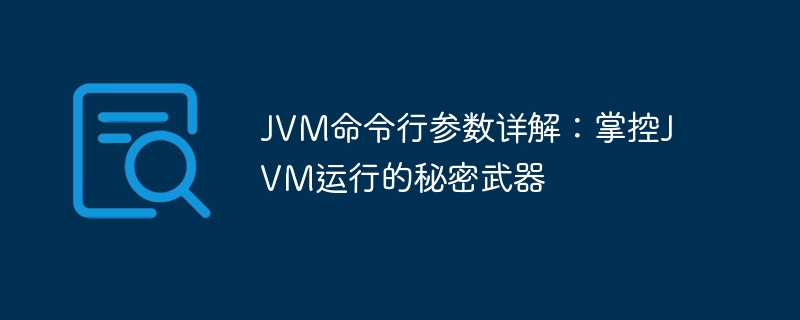Home >Java >javaTutorial >Detailed explanation of JVM command line parameters: the secret weapon to control JVM operation
Detailed explanation of JVM command line parameters: the secret weapon to control JVM operation
- 王林Original
- 2024-05-09 13:33:01890browse
Through JVM command line parameters, you can fine-grainedly adjust JVM behavior. The common parameters include: Set the Java heap size (-Xms, -Xmx) Set the new generation size (-Xmn) Enable the parallel garbage collector (-XX: UseParallelGC) Reduce the memory usage of the Survivor area (-XX:-ReduceSurvivorSetInMemory) Eliminate redundancy Garbage collection (-XX:-EliminateRedundantGCs) Print garbage collection information (-XX: PrintGC) Use the G1 garbage collector (-XX:-UseG1GC) Set the maximum garbage collection pause time (-XX:MaxGCPauseMillis)

Detailed explanation of JVM command line parameters: the secret weapon to control JVM operation
The Java Virtual Machine (JVM) is a complex and powerful tool that executes Java programs. provides the basis. By leveraging JVM command line parameters, you can fine-grained adjustments to JVM behavior to optimize application performance, resolve issues, or troubleshoot them.
Syntax
JVM command line parameters follow the following syntax:
java [options] <main class> [args...]
Where:
- options: JVM command line parameters, specify configuration options.
- main class: The main class name of the application.
- args...: Parameters passed to the application's main method.
Common parameters
The following are commonly used JVM command line parameters:
- -Xms: Set the Java heap minimum size.
- -Xmx:Set the maximum Java heap size.
- -Xmn:Set the young generation size.
- -XX: UseParallelGC: Use a parallel garbage collector.
- -XX:-ReduceSurvivorSetInMemory: Reduce the memory usage of the Survivor area.
- -XX:-EliminateRedundantGCs: Eliminate redundant garbage collections.
- -XX: PrintGC: Print garbage collection information.
- -XX:-UseG1GC: Use the G1 garbage collector (Java 9 and above).
- -XX:MaxGCPauseMillis: Set the maximum garbage collection pause time (Java 9 and higher).
Practical case
Example 1: Optimizing memory allocation
Use the following parameters to optimize Java heap allocation:
java -Xms256m -Xmx512m [main class]
This will set the Java heap minimum size to 256MB and maximum size to 512MB.
Example 2: Using Parallel Garbage Collection
Enable the parallel garbage collector using the following parameters:
java -XX:+UseParallelGC [main class]
This will take advantage of multiple CPU cores to execute in parallel Garbage collection, thereby improving performance.
Example 3: Print garbage collection information
Use the following parameters to print garbage collection information for troubleshooting purposes:
java -XX:+PrintGC [main class]
This will output information about garbage collection Detailed statistics on recycling events, pause times, and garbage collection.
These are just a few of the many JVM command line parameters. By understanding how to use these parameters, you can optimize application performance, solve problems, and troubleshoot them to take full advantage of the JVM's capabilities.
The above is the detailed content of Detailed explanation of JVM command line parameters: the secret weapon to control JVM operation. For more information, please follow other related articles on the PHP Chinese website!

